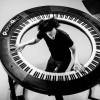-
Posts
1,489 -
Joined
-
Last visited
AlenK's Achievements
-
Why oh why would the MZ-X engineers implement such a silly restriction? PS. Looks like the arpeggio feature got increasingly defeatured on each new generation of models.
-
The MZ-X300 and MZ-X500 also support a programmable control track in user arpeggios. And there are two preset arpeggios called "Filtering" and "Panning Up" in the PX-5S, the PX-560, and the MZ-X arrangers that by their names I have to assume do something with the filter cutoff and stereo position, respectively, of whatever tones they are applied to. I am chagrined to admit I have never tried those particular arpeggios on my PX-560, so I don't know for certain what they actually do. One thing I would like to mention about the preset arpeggios is that the first keyboards whose documents identify which of them are step type and which are variation type are the MZ-X arrangers. The relevant documents for the XW synths, the PX-5S and the PX-560 do not show that information. I'm not saying anything that Mike doesn't already know, but for all of the models I named, the first 60 preset arpeggios are step type and the last 40 are variation type. And the variation-type presets are the same on all of those models. In fact, going by the documentation, the entire preset arpeggio list appears to be the same from the PX-5S on up to the MZ-X models. The XW synths have a different set of step-type arpeggios (no "Filtering" or "Panning Up") but 58 out of 60 of them are the same. I have lately been studying the preset arpeggios in my XW-P1. They are an interesting collection. I have also documented the parameters for all 100, information that does not appear in the XW-P1 Appendix and which most people wouldn't spend the time to collect. I wonder what the best way to share that information could be?
-
Yes, I figured there would be some in stage setting files. But I doubt user arpeggios show up in more than a few of them. Re Baba O’Reilly, I’m sure you did the Who proud. The number of user arpeggios posted for the XW synths, which are now 12 years old, is one data point that suggests rarity. That number is zero.
-
This is a question for anyone who has a Casio keyboard that allows programming of arpeggios. I am aware of five models that allow that: XW-P1, XW-G1, PX-5S, MZ-X300 and MZ-X500. Maybe I missed a few. In any case, here is the question: Who here has programmed their own arpeggios? If you have programmed your own, did it involve more than adding or creating a control track for a synthesis parameter (such as filter cutoff)? That’s something that Mike Martin demonstrated in a webinar for the PX-5S (below). So I would expect PX-5S users to at least do that. I ask because there are very few user arpeggios posted in the forums. I found only a handful for the PX-5S. Maybe most users of models that allow arpeggio editing are satisfied with the presets. Maybe arpeggio editing seems too difficult. Or maybe people edit when they need something different but feel no need to share their custom creations.
-
The last part of the next-to-last sentence doesn't make any sense either. AFAIK, count-offs as described (voice or claves) have not been added to the PX-560. (There is of course a metronome but that's not the same thing.) The comment from thompson1355 was in reference to the Boss DR drum machine. Seeing that post, I wonder if all or at least some of the posts from shaunaflynn were generated by a bot. With AI getting so good, a bot could conceivably generate replies that sort of make sense. But if so, I don't see what the end game is.
-
I don’t see how a reply would help. Shaunaflynn’s post was done in good faith but without realizing that Gary hasn’t been here in many years. He won’t be answering and I doubt he will even see it.
-
Just to let you know, Null (Gary) hasn’t posted here since 2016 and this thread is more than 8 years old. I don’t know if he even still reads the Casio Music Forums. I doubt it.
-
I remember that too. It was Hypnotuba: https://soundcloud.com/hypnotuba He (or she, who knows?) has some great examples there of wave sequencing, which is quite a different thing than what I'm talking about above but fascinating in its own right. There have been discussions in the forum about how to formalize wave sequencing as a technique on the XW-P1 and XW-G1. Monophonically, either XW synth can sequence the waves of up to four oscillators in the solo synth. If all four are needed in a tone, then it can do 16 waves in each of the four sequences. If no more than three oscillators are needed in a tone, then the technique presented here could extend their wave sequences to as many as 128 waves. PS. In one of the comments on the SoundCloud page at the link, Hypnotuba said he is a member of the forums here. If he still posts here, maybe he will chime in!
-
I’ve been experimenting with my XW-P1 again after a long absence. Yeah, I know, that’s a dangerous time sink for me. But I keep discovering things. Like how to chain the patterns of a sequence together without using the Chain feature. This is good if you don’t want to switch patterns interactively. Or if you just want patterns that are longer than 16 steps. The technique involves assigning the Step Sequencer Pattern Number Select NRPN to a knob and then sending values to that knob using a control track in the pattern. The values are unique to the pattern being played and serve to switch from the current pattern to another pattern, typically the next higher-numbered pattern or the first pattern, the latter in order to make the “mini-chain” into a loop. I always thought that this would work but for some reason, I never tried it until today. It works as I expected. For now, I will leave this as “an exercise for the student” because I don’t have the time to describe the specifics of how to do it. But anyone who really delves into my modest document here will be able to figure it out because all of the required elements are described there. Unfortunately, the technique doesn’t allow step editing across patterns. The XW-P1 ignores the Step Sequencer Pattern Number Select NRPN in step edit mode. A pity. PS. If someone here or elsewhere already posted about this capability here or elsewhere at some time since the XW synths were introduced, please let me know. I would want them to get proper credit for the technique.
-

Well, I guess no replacement - almost 10 years now
AlenK replied to aron's topic in Privia Pro PX-5S
Although it’s reasonable to say that it’s not over yet because some sources still have stock of the PX-5S, I’m pretty sure Casio has stopped making them. Most sites I visit claim it has been discontinued. In any case, it’s clear that Casio completely gave up on the pro (stage) keyboard market years ago. I think that was a real shame. Unless senior management decides on another course correction, I don’t think we’ll ever see from Casio another pro keyboard meant for stage use again. -
Great influences and it sounds like we have similar musical tastes. Ultravox (Midge Ure era) is one of my favorite bands. I used to buy all their albums in the eighties (on vinyl, of course). Rage in Eden is one of their best. “The Voice” is a classic song from it. And of course, Numan and Jarre were great in their day too, although I was a little more selective with them when it came to spending money on albums. Numan is still going strong and seems like a hell of a nice guy to boot, as well as disarmingly modest for a musician with his discography. Re your composition, I was recently trawling through SoundCloud to see what XW-P1/G1 material I could find. Your song stood out as one of the best tracks, and certainly in my mind the best original composition I could find using the XW synths.
-
Also, the filters in Hex Layer mode are multi-mode. Choosing a high-pass filter for a wave on one layer and a low-pass filter or no filter at all for the same wave on another layer and adjusting their relative volume levels, can act like an equalizer to accentuate high frequencies to your taste. You can also adjust the “key follow” if the resulting sound gets too bright at the top end. There is a lot of flexibility in the Hex Layer engine on the PX-560 and the filters sound really smooth.
-
Great times, right? It’s been almost 12 years since the P1 and G1 were released and more than 10 years since I got my own P1. I can’t say I have done a lot with it beyond research and write a certain infamous document related to it. And of late, I haven’t had a lot of time to spend with it. But every time I sit down at it, I am reminded of how much it can do that I really like and how well I think it still holds up to more recent offerings I have seen. I sometimes get GAS about newer synths but then I realize I haven’t even really tapped the potential of the few synths I already own (P1, PX-560, Roland D-10). I will grant that It can take a lot of work to drag decent tones out of the P1, depending on what “decent” means to you, but “decent” it most certainly can do.
-
I didn’t know there was a data editor for the XW-PD1. The sequencer editor looks good. Too bad there isn’t a similar visual sequence editor for the XW-P1 (and XW-G1, since it has the same sequencer). I’ll bet it wouldn’t have taken all that much work for Casio to get the code for the sequence editor in the XW-PD1 data editor to work with the P1 and G1 models. But I understand why they didn’t do such a major upgrade to data editors that only support a couple of somewhat older models. Would have been nice, though.




